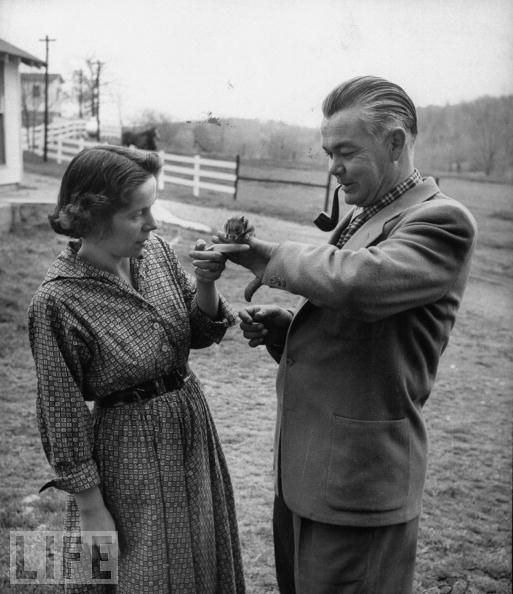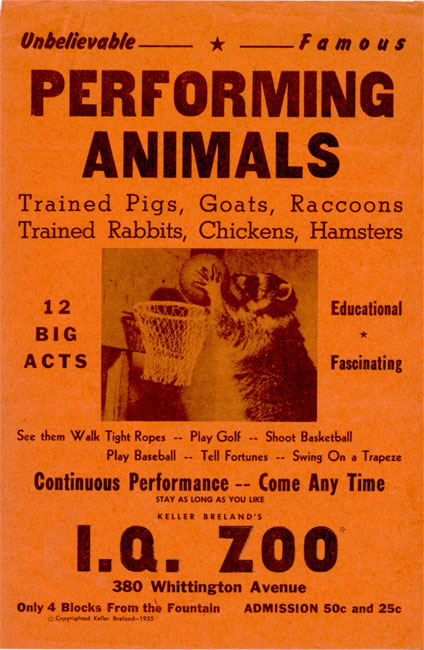
Marian Breland and Keller Breland, March 15, 1955. Source
Who invented animal training?
The question is silly on its face. Animal training is older than the hills. For certain, it is as old as the dog.
That said, most of what we call animal training today is what the fancy talkers call "operant conditioning," a term first coined by psychologist B.F. Skinner in the early 1930s in an effort to dress up an even older concept -- learning from consequences.
B.F. Skinner did not invent operant conditioning any more than Newton invented gravity.
That said, Skinner DID codify the basic principals of operant conditioning, and he did invent mechanical-based operant conditioning, i.e. the "Skinner box" a mechanical device that awarded animals with food for pulling levers, pecking at spots, and doing other slightly more complicated learned behaviors.
Perhaps just as importantly, B.F. Skinner brought into the world of operant conditioning several people who helped shape the way we train animals today.
In fact, I do not think it is too much to say that two of his students -- Marian Ruth Kruse and Keller Breland -- invented modern animal training.
The story begins in the very early 1930s when B. F. Skinner was a researcher at Harvard working on something he called an "operant conditioning chamber" -- a device which measured the response of animals to stimulus. This later became the first "Skinner box" or animal teaching machine.
In 1936, Skinner left Harvard to teach at the University of Minnesota, where he began expanding on his earlier work.
In 1938, he took on his second student assistant, a young 18-year old girl by the name of Marian Ruth Kruse.
In 1940, Skinner added Keller Breland to his team of graduate student assistants.
Keller Breland and Marian Rught Kruse fell in love, and in 1941 they were married.
Marian and Keller Breland learned the basics of operant conditioning from B.F. Skinner, and helped him to train thousands of rats and pigeons used in various experiments and projects.
Once particularly important project began in 1941, when Skinner and his assistants were hired by the U.S. Navy to see if pigeons could be trained to guide bombs to their targets.
While pigeon-guided bombs never made it to the battle field, the operant conditioning techniques learned during this period of stable Navy funding suggested to Mariann and Keller Breland a possible business opportunity.
Was there a market for trained animals? They thought there might be.
When, in 1945, B.F. Skinner was lured away from Minnesota to teach at the University of Indiana, they Brelands decided to see if they could make a go of it on their own as commercial animal trainers and contract researchers and consultants.
It seemed an unlikely way to make a fortune.
Skinner had mostly trained rats and pigeons. If the Brelands were to support themselves as animal trainers, however, they would have to train higher animals than that!
Yes, the basic elements of operant conditioning had been used, off and on, and in a largely chaotic way, to train many species around the world over a thousand years. But most of this real-world experience was now lost to time and was little more than rumor or anecdote.
Could the basics of rat and pigeon training be scaled up and used across a wide variety of species? And if it could, would there be a market for such a thing? Would it be a large enough market to put food on the table, and gas in the car?
No one knew, least of all the Brelands. They took the plunge, nonetheless, buying a small farm in Mound, Minnesota and forming a company they called Animal Behavior Enterprises (ABE).
ABE's goals were three-fold and reflected their slightly tenuous business plan: to produce trained animals in profusion for an unknown commercial market, to engage in contract research if they could find anyone willing to underwrite that, and to consult on operant conditioning if they could find anyone willing to pay for their advice.
To say bravery was involved in this economic venture is an understatement. To those on the outside, including family and friends, it seemed sheer madness.
The Brelands had a secret, however: they were pretty good animal trainers, and they also had a growing body of evidence that suggested operant conditioning was a very robust training methodology.
In 1943, the Brelands, working with B.F. Skinner, had discovered the power of shaping behaviors by using a simple hand-held food-delivery switch. Now, instead of being rewarded for actually completeting the task, an animal could be rewarding for "approximating" the task -- a behavior that could be "shaped," by degrees, to the actual desired behavior.
A simple hand-held food delivery switch was, in effect, the first massive leap forward beyond the Skinner Box.
By 1945, the Brelands had gone even further. The mechanical construction of Skinner boxes had led the Brelands to a new idea; that small noises, such as those produced by the mechanical apparatus inside a Skinner box, or the noise made by a hand-held switch, might be an important part of the training process itself.
Experimenting with this idea, Keller and Marian Breland discovered that an acoustic secondary enforcer, such as a click or whistle, could communicate to an animal what precise action was being done that was actually resulting in a food reward.
Keller and Marian called this a "bridging stimulus," and found it dramatically sped up animal training by increasing the amount of information going to an animal. Most importantly of all, it seemed to work well with all animals. Important stuff!
In 1946, Animal Behavior Enterprise's got its first animal training contract with General Mills. The assignment was to train farm animals to appear in feed advertisements.
This first successful contract led to more contracts, first for in-store promotional animals, and then for animals to be used in movies, circuses, museums, and zoos.
In addition to providing trained animals, the Brelands were also asked to train workers and producers in how to work with those animals when they were sent on location.
From the beginning, "training the trainers" became an adjunct business to providing the trained animals themselves.
While the Brelands had worked almost exclusively with rats, pigeons and chickens when employed by Skinner, they now found themselves training everything: dogs, cats, pigs, cattle, chickens, goats, sheep, raccoons, rabbits, ducks, parrots, ravens, deer, and monkeys.
At one point, the Brelands had more than 1,000 animals under training at a single time. Over the course of a lifetime, scores of thousands of animals, representing more than 140 species, were trained by the Brelands. Of course, it did not take too long for the Brelands to outgrow their small Minnesota farm, and it took even less time for them to realize that long, cold Minnesota winters were not too conducive to animal training outside of a laboratory setting.
Of course, it did not take too long for the Brelands to outgrow their small Minnesota farm, and it took even less time for them to realize that long, cold Minnesota winters were not too conducive to animal training outside of a laboratory setting.
In 1951 the Brelands moved to Hot Springs, Arkansas, a central location well-served by the railroads, where land was cheap and the weather was not too bad.
There they continued to train animals and animal trainers, and they also started a cash-concern they called the "IQ Zoo" which featured various animals doing amusing tricks, from basketball-playing raccoons and drum-playing ducks, to a printing press operated by reindeer and a chicken that would take on all comers in games of tick-tack-toe.
Though Keller and Marian Breland were equals at ABE, their division of labor suited their personalities and the flavor of the times.
Keller was the public face who traveled and did most of the show presentations and who promoted and expanded on the theory, while Marian was the engineer who made sure everything ran like a clock and actually operationalized everything at the level of fur, fin and feather.
Throughout the 1950s and 60's business was booming, with the Brelands signing contracts with Marineland of Florida, Parrot Jungle, and Six Flags.
In 1955, the Brelands produced the first trained dolphin show at Marine Studios in St. Augustine, Florida, and in 1957 they produced the first trained-whale shows at Marine Studios in Florida, and Marineland of the Pacific in Palos Verdes, California.
The work of the Brelands did not go unnoticed. Not only did the Brelands train other animal trainers who went on to places like Busch Gardens and Disney World, and Sea World, but they were also contracted with by the U.S. Navy to see if dolphins could be trained to do surveillance and salvage work.
It was during this time, that Keller and Marian Breland met Bob Bailey, who was the first Director of Training for the U. S. Navy Marine Mammal Program.
In 1965, Keller Breland died of a heart attack, leaving Marian with three semi-grown children, and Bob Bailey stepped up as as General Manager of ABE.
Marian and Bob continued on with ABE, signing a contract with the U.S. Navy to manage their Marine Mammal Facility in Key West, Florida from 1967 to 1969.
Along the way love blossomed between Bob Bailey and Marian Breland, and they married in 1976, adding Bob's six young children (three sets of twins!) to the now rapidly growing family.
In the 1980s, the Baileys began to phase out the commercial subdivisions of Animal Behavior Enterprises in order to simplify their life and devote more time to teaching. After a 1989 fire destroyed a lifetime of research, including thousands of hours of historical film, the Baileys decided to close ABE for good.
Marian Breland Bailey died on September 25, 2001, in Hot Springs Arkansas, and her ashes were taken to Bush Key, seventy miles west of Key West, Florida, where she had spent so much time training dolphins.
Bob Bailey continues to train teachers in the basics of operant conditioning, and his own contribution to animal and human training will be featured in a later post.
Suffice it to say that if you have heard of clicker training, it's due in no small part to Bob Bailey, whether you know that or not!
And if you have ever trained an animal in the last 40 years, you have stood on the shoulders of Marian and Keller Breland and Bob Bailey, whether you know that or not.
When the history of animal training is written let it be said that these three remarkable individuals invented or perfected so much of what we take for granted today.
No comments:
Post a Comment